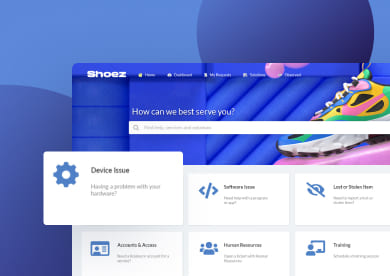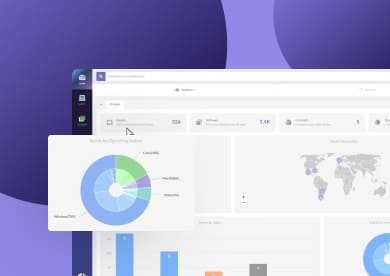How to manage an IT team is one of those questions that sounds simple until you’re actually the one in charge. How do you keep projects on track while keeping people engaged? How do you balance business goals with daily support tasks? And how do you build a team that’s not just productive, but proud of the work they do.
At InvGate, we know just how big of a task it is to build, run, and lead an IT team. Whether you’re managing a small in-house group or overseeing a distributed department across multiple time zones, the challenges are real and constant.
That’s why we’ve put together a list of practical strategies to help managers navigate the complexities of leading a technical team, based on our extensive experience in the IT sector.

1. Align technical priorities with business goals
IT teams can’t operate in a vacuum. As a manager, your role is to connect day-to-day tasks with the company’s bigger picture. That can mean improving customer experience, cutting costs, or enabling growth.
Make sure your team knows why their work matters. Context builds motivation, and aligning efforts with business goals ensures you’re not just "staying busy," but actually moving forward.
2. Formalize your processes (but keep them flexible)
Clear processes help your team stay organized and consistent. But but rigid rules can quickly become roadblocks. The key is finding the right balance.
Document workflows, define responsibilities, and set standards. Then, revisit them often with your team to make sure they still make sense. What worked a year ago might not work today. Processes should support your people, not slow them down.
3. Don’t underestimate the impact of morale
Technical skills keep systems running, that's for sure. But morale is what keeps people going. When motivation drops, so does performance, even in the most skilled teams.
Create space for connection, celebrate small wins, and check in regularly. A motivated team is more resilient, collaborative, and engaged, especially when things get tough.
“If morale drops, it is crucial to how I feel… and, you know, am I excited about work? Do I like coming to work? And if I don’t, what am I doing here?”
Sandy Confer, IT Support Specialist at Penn State University
4. Treat feedback as a design tool, not just a correction mechanism
Feedback is a source of insight. Use it to improve workflows, uncover roadblocks, and adjust priorities.
Ask often, listen actively, and act on what you hear. Continuous input from your team helps you shape better processes and make smarter decisions.
5. Give structure to social connection (especially for remote teams)
Team bonding doesn’t happen by chance, especially when people work remotely or in hybrid setups.
Set up regular check-ins, casual chats, or fun rituals that go beyond work. These moments strengthen relationships and help build trust, which directly impacts how your team collaborates.
6. Make everyday wins visible
A lot of IT work goes unnoticed when everything runs smoothly. But just because it’s invisible doesn’t mean it’s not valuable.
Create simple ways to highlight progress. It could be really simple things, like a "wins" channel, a quick mention in meetings, or a shared dashboard. Celebrating the small stuff keeps morale up and reminds the team their work matters.
“Recognition feels really good… I have a very remote team… finding that moment to call this person or that person to say, ‘Hey, I received positive feedback about you,’… it takes you the extra mile and puts a smile on the agent’s face.”
Moe Sulliman, Technology Help Desk Manager at Wajax
7. Delegate with purpose and not just to unload tasks
Delegating isn’t about getting things off your plate; it’s about helping people grow.
Assign responsibilities based on each person’s strengths and development goals. When delegation is intentional, it builds trust, boosts engagement, and strengthens the team as a whole.
8. Design communication with different depths in mind
Not everything needs a meeting, right? But also, not everything can be solved in a quick chat.
Build a mix of communication channels: async updates, real-time chats, structured meetings, and deeper one-on-ones. Giving each topic the right space helps avoid misunderstandings and keeps things moving.
9. Regularly review friction points
The small stuff adds up. Slow approvals, unclear handoffs, duplicated steps can wear your team down.
Make it a habit to ask what’s getting in the way. Identifying and fixing friction points improves both efficiency and team satisfaction.
“The ability and the willingness to get the feedback of your frontline staff makes your initiatives way better. Way better.”
Sally Mildren, Chief Executive Officer and Managing Partner of Boss Lady Consulting
10. Turn metrics into conversations
Metrics shouldn't just be scoreboards. They should spark dialogue.
Use KPIs to start discussions about what’s working, what’s not, and where to improve. Make sure the team is part of interpreting the data. That way, they'll be more invested in the results.
11. Promote autonomy with context
Giving autonomy doesn’t mean stepping away completely. Make sure your team has the clarity, tools, and support they need to make decisions confidently. Autonomy works best when everyone knows the boundaries and the goals.
12. Plan ahead for high-demand periods
IT teams often face seasonal peaks. This is differente for every team and could be related to new hires, audits, launches.
Don’t wait for the stress to hit. Identify these moments early and prepare with extra support, clear priorities, and stronger communication. Anticipation beats crisis mode every time.
Human Centered Leadership
Discover the power of embracing the human element in IT and leadership
Download for free
13. Pay attention to what’s not being said
Silence can signal more than words. Disengagement, hesitation, or sudden drops in performance often point to deeper issues.
Stay alert to subtle shifts, and create safe spaces for honest conversations. Sometimes the real problems aren’t reported. They’re felt.
14. Equip your team with the right tools
Even the best IT teams can struggle without the right support. Processes, goals, and talent matter, but so does the technology that ties it all together.
Choose tools that actually make your team’s work easier, not harder. From tracking tickets to managing assets, the right platforms can reduce manual work, improve visibility, and boost overall efficiency.
There are plenty of options out there, but if you're looking for an integrated approach, InvGate Service Management and InvGate Asset Management are two powerful solutions worth considering. Together, they give your team everything they need to manage requests, track assets, and stay one step ahead.
15. Measure and improve emotional intelligence in leadership
Your team's performance is directly influenced by how emotionally intelligent its leaders are. Managers who are self-aware, empathetic, and mindful of their communication foster healthier team dynamics, reduce burnout, and elevate customer experience.
It’s not just about soft skills—it’s about creating a stable foundation for sustainable success.
“There is a direct correlation between the customer’s experience and the management’s emotional intelligence.”
Deborah Monroe, President at Ignite Achievements International
In short
There’s no one-size-fits-all approach to managing an IT team. But with the right strategies, you can build a group that’s not only technically strong, but also connected, motivated, and aligned with your organization’s goals.
At the end of the day, effective IT Management isn’t just about keeping systems up and running. It’s about leading people. And when your team feels supported, heard, and empowered, everything else tends to follow.















